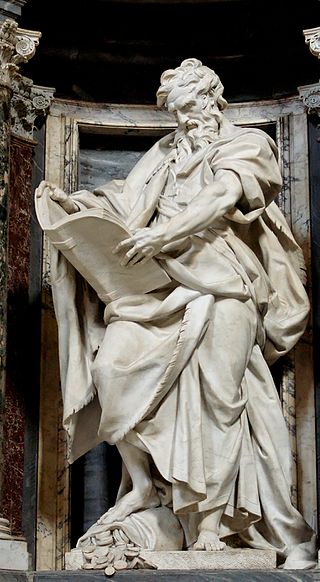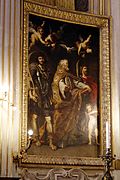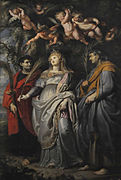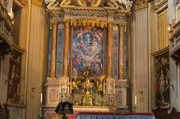
An altarpiece is an work of art in painting, sculpture or relief representing a religious subject made for placing at the back of or behind the altar of a Christian church. Though most commonly used for a single work of art such as a painting or sculpture, or a set of them, the word can also be used of the whole ensemble behind an altar, otherwise known as a reredos, including what is often an elaborate frame for the central image or images. Altarpieces were one of the most important products of Christian art especially from the late Middle Ages to the era of Baroque painting.

The Church of St. Ignatius of Loyola at Campus Martius is a Latin Catholic titular church, of deaconry rank, dedicated to Ignatius of Loyola, the founder of the Society of Jesus, located in Rome, Italy. Built in Baroque style between 1626 and 1650, the church functioned originally as the chapel of the adjacent Roman College, which moved in 1584 to a new larger building and was renamed the Pontifical Gregorian University. It is one of the great 17th century preaching churches built by Counter-Reformation orders in the Centro Storico.

Madonna Della Strada or Santa Maria Della Strada is a painting of Mary, mother of Jesus at the Church of the Gesù in Rome, mother church of the Society of Jesus (Jesuits) religious order of the Catholic Church; it is a variation on the basilissa (imperial) type of icon.

Federico Barocci was an Italian Renaissance painter and printmaker. His original name was Federico Fiori, and he was nicknamed Il Baroccio. His work was highly esteemed and influential, and foreshadows the Baroque of Rubens. He is generally considered the greatest and the most individual painter of his time in central Italy.

The Church of the Gesù, officially named Chiesa del Santissimo Nome di Gesù, is a church located at Piazza del Gesù in the Pigna rione of Rome, Italy. It is the mother church of the Society of Jesus. With its façade, described as "the first truly baroque façade", the church served as a model for innumerable Jesuit churches all over the world, especially in Central Europe and in Portuguese colonies. Its paintings in the nave, crossing, and side chapels became models for art in Jesuit churches throughout Italy and Europe, as well as those of other orders. The Church of the Gesù is one of the great 17th-century preaching churches built by Counter-Reformation orders like the Jesuits in the Centro Storico of Rome – the others being Sant'Ignazio, also of the Jesuits, San Carlo ai Catinari of the Barnabites, Sant'Andrea della Valle of the Theatines, and the Chiesa Nuova of the Oratorians.

Sant'Andrea della Valle is a titular church and minor basilica in the rione of Sant'Eustachio of the city of Rome, Italy. The basilica is the seat of the general curia of the Theatines and is located on the Piazza Vidoni, at the intersection of Corso Vittorio Emanuele and Corso Rinascimento. It is one of the great 17th century preaching churches built by Counter-Reformation orders in the Centro Storico.

Pancras was a Roman citizen who converted to Christianity and was beheaded for his faith at the age of fourteen, around the year 304. His name is Greek, meaning 'all-powerful'.

Caravaggio created one of his most admired altarpieces, The Entombment of Christ, in 1603–1604 for the second chapel on the right in Santa Maria in Vallicella, a church built for the Oratory of Saint Philip Neri. A copy of the painting is now in the chapel, and the original is in the Vatican Pinacoteca. The painting has been copied by artists as diverse as Rubens, Fragonard, Géricault and Cézanne.

Santi Nereo ed Achilleo is a fourth-century basilica church in Rome, Italy, located in via delle Terme di Caracalla in the rione Celio facing the main entrance to the Baths of Caracalla. It has been the titular church of Cardinal Celestino Aós Braco since 28 November 2020. Unusually it is part of a detached portion of the parish of Chiesa Nuova rather than the local geographical parish of San Saba and is served by Oratorians as a satellite of the Roman Oratory.

Nereus and Achilleus are two Roman martyr saints. In the present General Roman Calendar, revised in 1969, Nereus and Achilleus (together) are celebrated on 12 May.

Santa Maria in Vallicella, also called Chiesa Nuova, is a church in Rome, Italy, which today faces onto the main thoroughfare of the Corso Vittorio Emanuele and the corner of Via della Chiesa Nuova. It is the principal church of the Oratorians, a religious congregation of secular priests, founded by St Philip Neri in 1561 at a time in the 16th century when the Counter Reformation saw the emergence of a number of new religious institutes such as the Jesuits, the Theatines, and the Barnabites. These new congregations were responsible for several great preaching churches built in the Centro Storico, the others being Sant'Andrea della Valle (Theatines), San Carlo ai Catinari (Barnabites), and The Gesù and Sant'Ignazio (Jesuits).
Flavia Domitilla was a Roman noblewoman of the 1st century AD. She was a granddaughter of Emperor Vespasian and a niece of Emperors Titus and Domitian. She married her second cousin, the consul Titus Flavius Clemens, a grand-nephew of Vespasian through his father Titus Flavius Sabinus.

Petronilla is an early Christian saint. She is venerated as a virgin by the Catholic Church. She died in Rome at the end of the 1st century, or possibly in the 3rd century.

Cristoforo Roncalli was an Italian mannerist painter. He was one of the three painters known as Pomarancio or Il Pomarancio.

Camillo Rusconi was an Italian sculptor of the late Baroque in Rome. His style displays both features of Baroque and Neoclassicism. He has been described as a Carlo Maratta in marble.

The Abbey of Santa Giustina is a 10th-century Benedictine abbey complex located in front of the Prato della Valle in central Padua, region of Veneto, Italy. Adjacent to the former monastery is the basilica church of Santa Giustina, initially built in the 6th century, but whose present form derives from a 17th-century reconstruction.

The Treasure Museum of the Basilica of Saint Francis contains a collection of sacred art that is on display in two halls found on the northern side of the Cloister of Pope Sixtus IV which is part of the Sacro Convento in Assisi, Italy. The entrance is found on the second level of the Renaissance cloister behind the apse of the Basilica of Saint Francis, which houses the remains of St. Francis of Assisi. Since 1986 the museum has also displayed a collection of works donated to the Conventual Franciscan Friars by the Secular Franciscan and American art critic, Frederick Mason Perkins, who died in Assisi in October 1955.

The Catacombs of Domitilla are an underground Christian cemetery named after the Domitilla family that had initially ordered them to be dug. Located in Rome, Italy, are the human-made subterranean passageways used for cemeteries and religious practice. They are among the largest catacombs in Rome, spreading out 17 km, largely along the ancient Via Ardeatine, laid out on four levels, and housing approximately 15,000 bodies underground. The Catacombs of Domitilla are the only catacombs in Rome that have an underground Basilica and are one of only five Roman catacombs open to the public. Constructed during the second and third centuries, this labyrinth of underground passages contains frescoes and a wealth of Christian iconography while also presenting masterful engineering skills and innovative architectural techniques.

Papias and Maurus were a pair of Christian martyrs from an unknown era of persecution. Their cult as saints dates back to at least the 7th century and is recorded in pilrgim itineraries which record them as originally being buried in the Large Catacomb on via Nomentana. The Roman Martyrology records them on 29 January. Papias is sometimes mispelled Papianus.

Saint Gregory with Saints or Pope Saint Gregory, Surrounded by Saints, Venerating the Miraculous Image of the Madonna and Child, known as the Santa Maria in Vallicella is a 1606-1607 oil on canvas painting by Peter Paul Rubens, now in the Musée de Grenoble. It is the first version of his Madonna della Vallicella and incorporates the six saints shown in that work's accompanying works.























